Insights
Jun 29, 2020 _ insights
A Healing State of Mind: Salutogenesis & Stress in Cancer Care Environments
We all know how much stress takes out of us. It’s well documented, but we’ve also all felt it: how it compromises our well-being, depresses our immune system, and suppresses our mental faculties, making processing complex thoughts and decisions more difficult. Now imagine the stress of a cancer diagnosis: How do you process all the emotions (the fear and anger, the sense of helplessness), the strains on your finances and relationships, the complex medical terms, testing and treatment protocols? How do you make good choices?
Managing the stress of cancer (or any illness) is an important first step toward enabling patients to heal. A pioneer in the study of the impacts of stress on the progression of disease, medical sociologist Aaron Antonovsky observed that we are all somewhere on a spectrum between perfect health and illness. What enables us to move towards wellness are the resources available for us to cope. His theory of salutogenesis (health generation) addresses this “wellness bank account” of available physical and mental resources. Because healing requires that we spend physical and mental resources, we need to consider ways that the built environment can help address the deficits caused by stress and disease.
At GBBN, we approach the design of healthcare facilities with the intent of creating salutogenic spaces. Especially in cancer care, we ask the question, “How can the built environment enhance healing?” As architects, we understand that we can’t cure diseases or control the amount of stress (wellness deficit) a patient might bring with them into a space. But once there, we can surround them in an atmosphere designed to enhance and replenish the resources they have available to deal with their illness.
We like to think about salutogenesis as composed of five aspects, each with a simple phrase denoting how it impacts wellness:
- Sense of coherence (I understand)
- Self-efficacy (I can)
- Biophilia (I relate)
- Prospect and refuge (I shelter)
- Relaxation response (I restore).
Each of these experiences decreases patient stress and replenishes the resources available to cope with their illness. As we design each element of a healthcare project (arrival, registration, labs, exam rooms, meeting and clinical space) we ask how the space can foster these health-generating experiences and provide the resources a patient needs to heal.
In “Oncology Evolution: How Multidisciplinary Care is Impacting Design”—a webinar we will be delivering as part of the 2020 Planning, Design & Construction (PDC) Summit—we detail specific ways GBBN leverages salutogenesis by discussing our design of TriHealth’s Harold M. and Eugenia S. Thomas Comprehensive Care Center. Through the story of this building and the accompanying images, you can see the impact of salutogenesis in design.
ENTRY
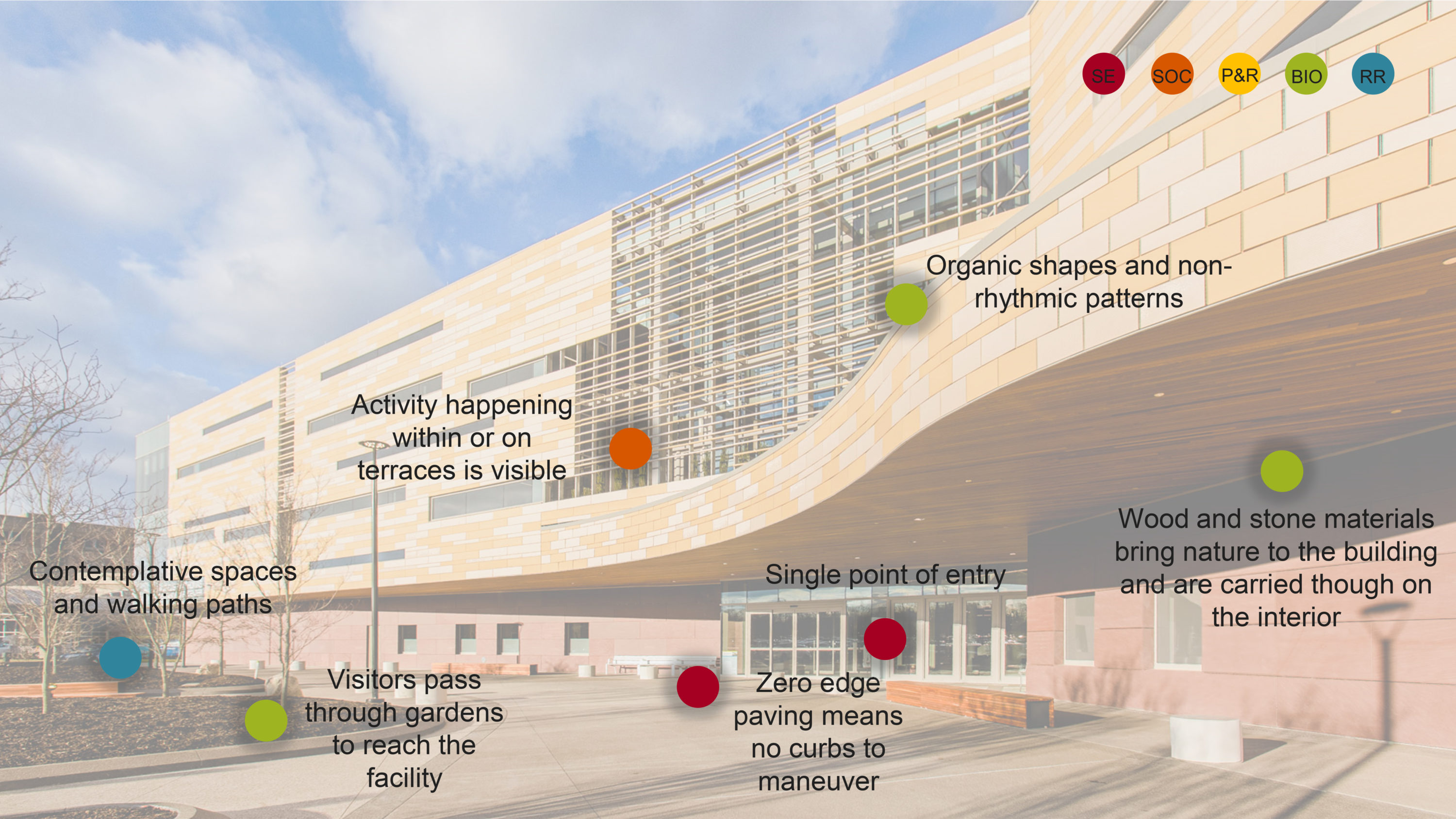
Passing through gardens and encountering the building’s organic shapes and non-rhythmic patterns as they approach, patients experience an instinctive connection to their surroundings (biophilia). The walking paths and benches they encounter provide opportunities for contemplation (relaxation response), while the activity they are able to see on the terrace and within the building signals the community-centered environment that they can understand and navigate (sense of coherence). By removing typical barriers to access and providing simple wayfinding, the entry instills confidence (self-efficacy).
ATRIUM
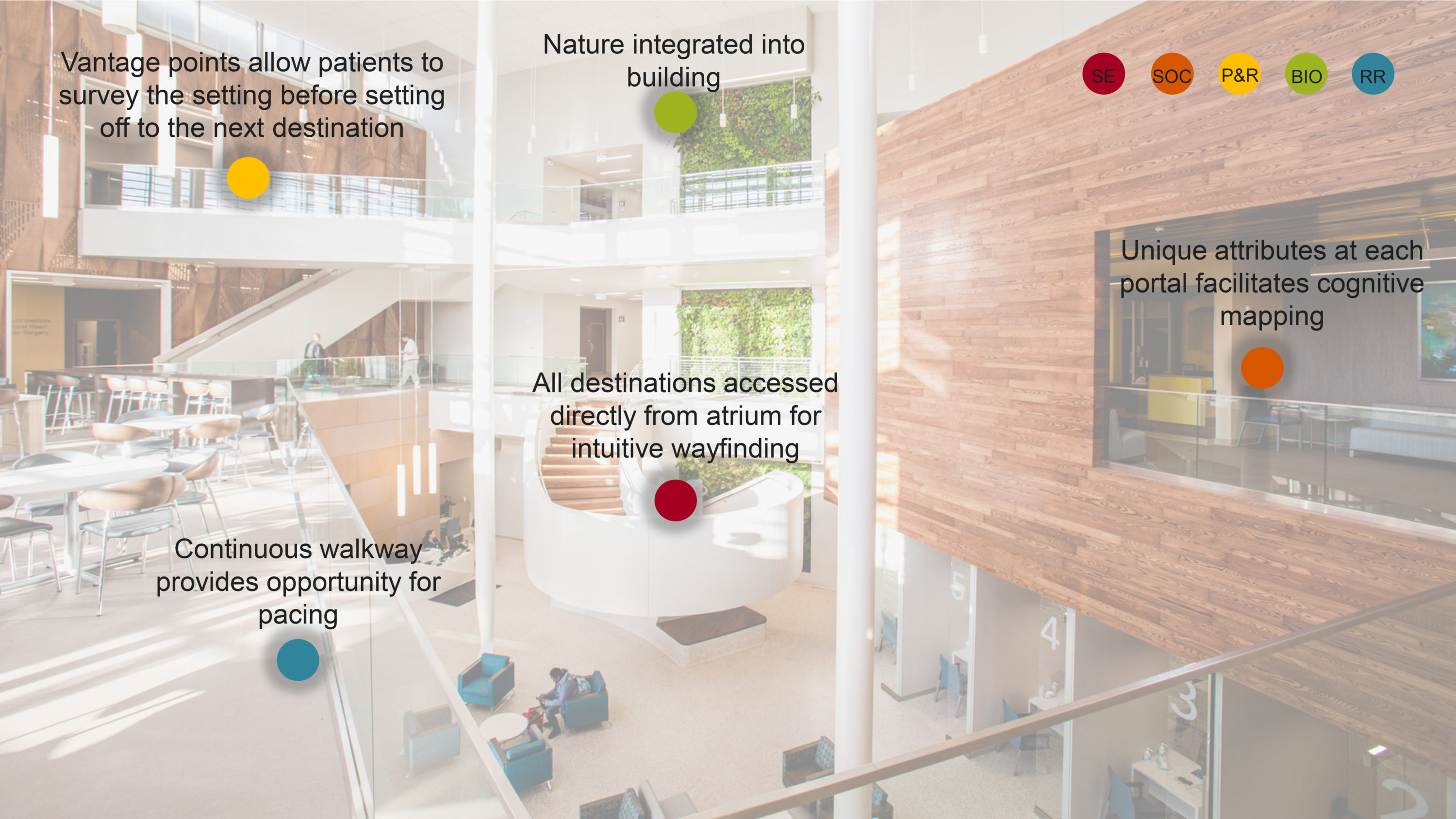
As patients pass into the building, they find themselves within a bright, airy atrium, with a striking, multistory wall of living foliage and therapeutic views of the landscape that maintain their connection to nature (biophilia). The continuous, wraparound walkway and stairs provide opportunities for physical movement and positive distractions (relaxation response) along with vantage points from which to survey the whole space or find shelter and comfort (prospect and refuge). The large building seems manageable and comprehensible because it is organized into a series of highly-visible destinations (sense of coherence). Scanning the perimeter of the atrium, patients can not only easily locate their destination, but they find an abundance of resources like financial, genetic, and nutritional counseling arrayed before them (self-efficacy).
CAFÉ
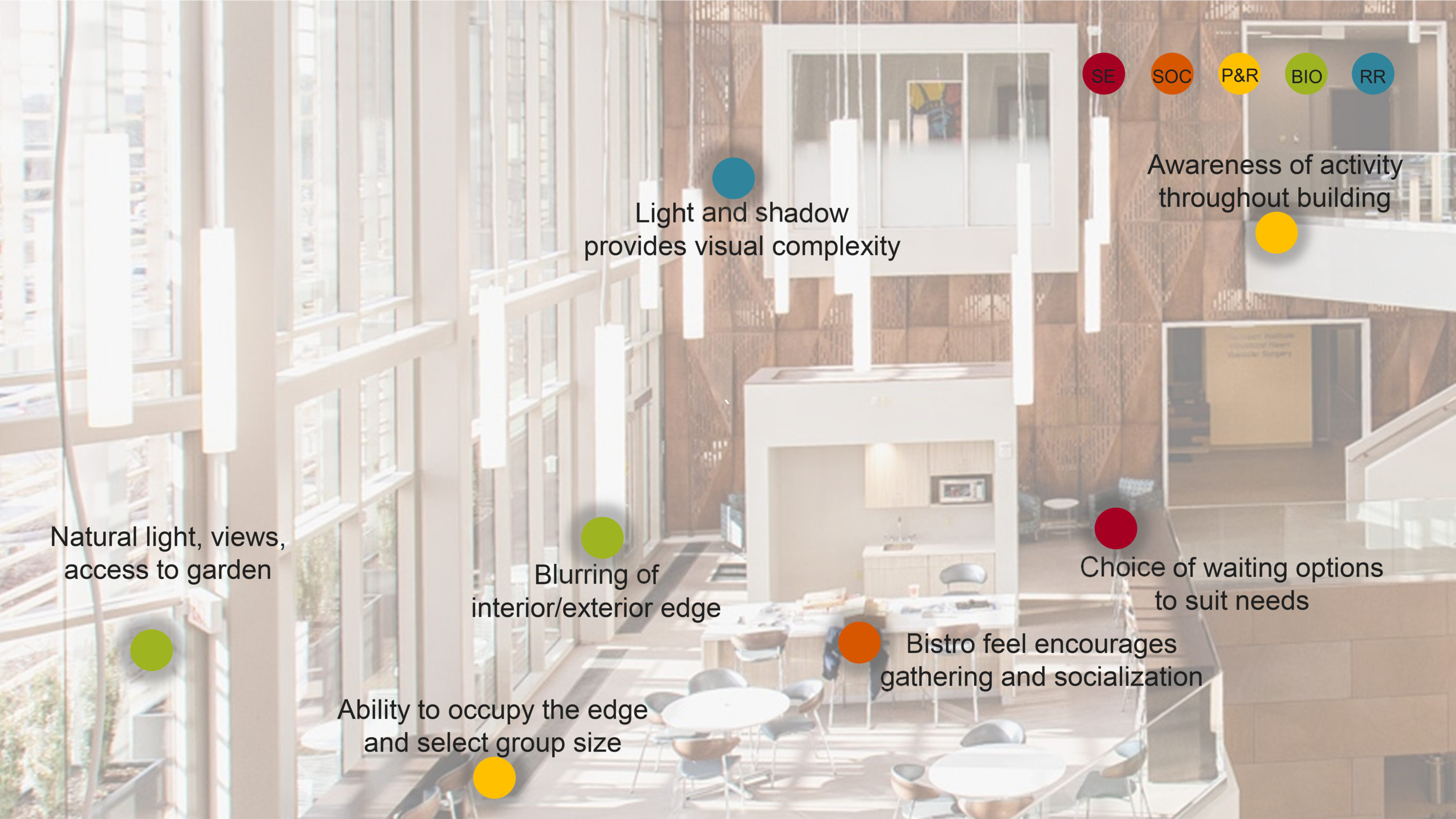
Ample light pours into the second-floor café from full height windows that blur the edge of interior and the adjacent terrace garden. This calming connection to nature—reinforced by the living wall opposite the café—creates a restorative environment in which to destress and recover between appointments (biophilia, relaxation response). Providing food and drink, the bistro-look creates an association with pleasant experiences (sense of coherence) and encourages socialization, while varied seating options allow people to decide where and how to engage with others – deciding whether to occupy a quiet edge along the windows or to join a large table in the middle (self-efficacy, prospect and refuge).
CLINIC
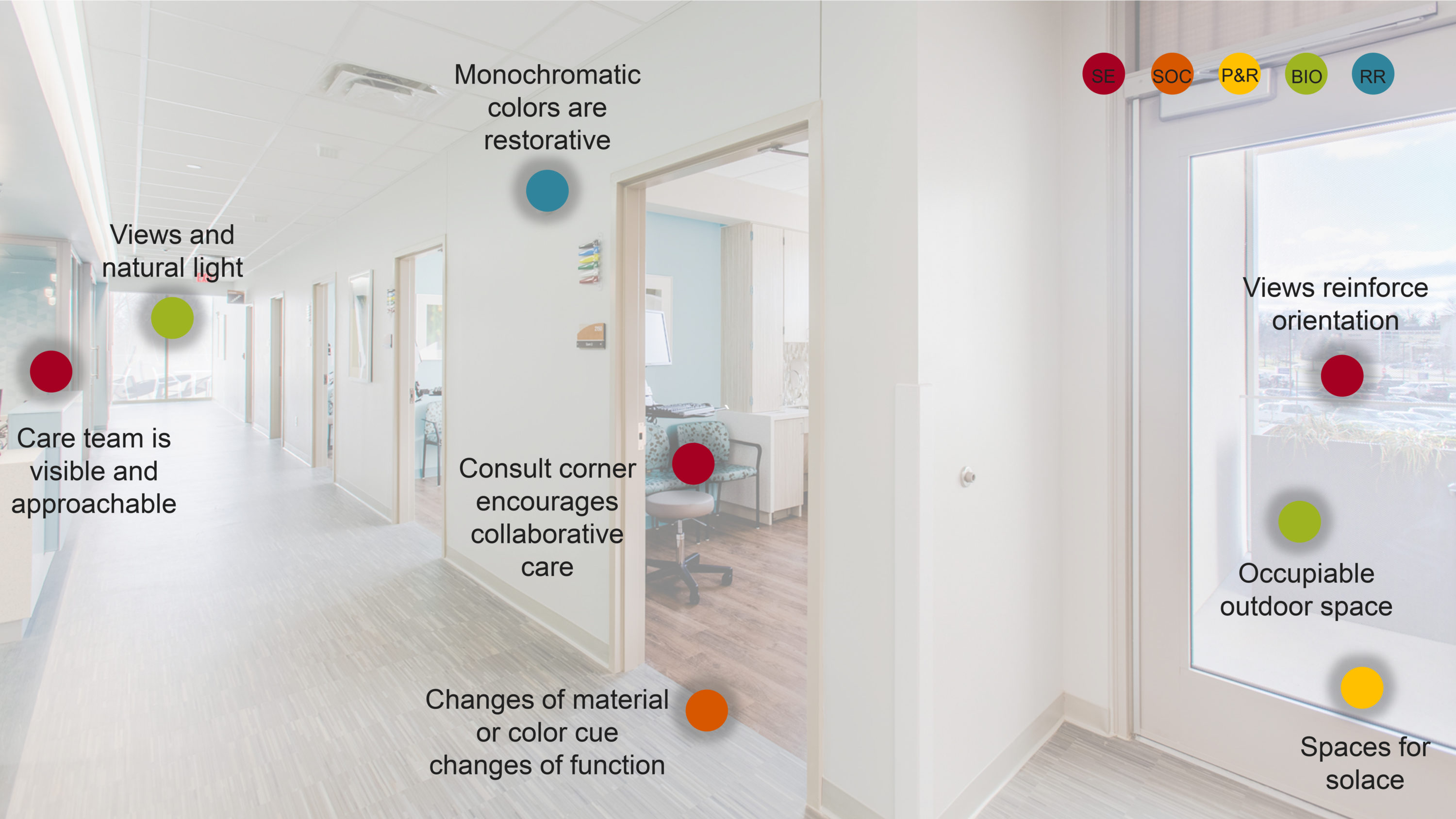
As patients enter the Thomas Center’s clinic spaces, they will find a relaxing and easily-navigated environment. The monochromatic color palette is restorative (relaxation response). Changes in material and color cue changes of function or destinations easing wayfinding by making the clinic’s layout immediately intelligible (sense of coherence). Views to the outside allow ongoing connection to nature and natural light (biophilia) while also allowing patients to orient themselves within the space (self-efficacy). Patient empowerment is reinforced by the central position of the care team, which makes them visible and approachable, while a consult corner, built into each exam room, encourages collaborative care between patients and clinicians (self-efficacy). Occupiable outdoor areas and quiet haven areas in each clinic are reserved for healthcare providers, giving them much-needed respite spaces in which to process the daily stress of their jobs (biophilia, relaxation response).
INFUSION
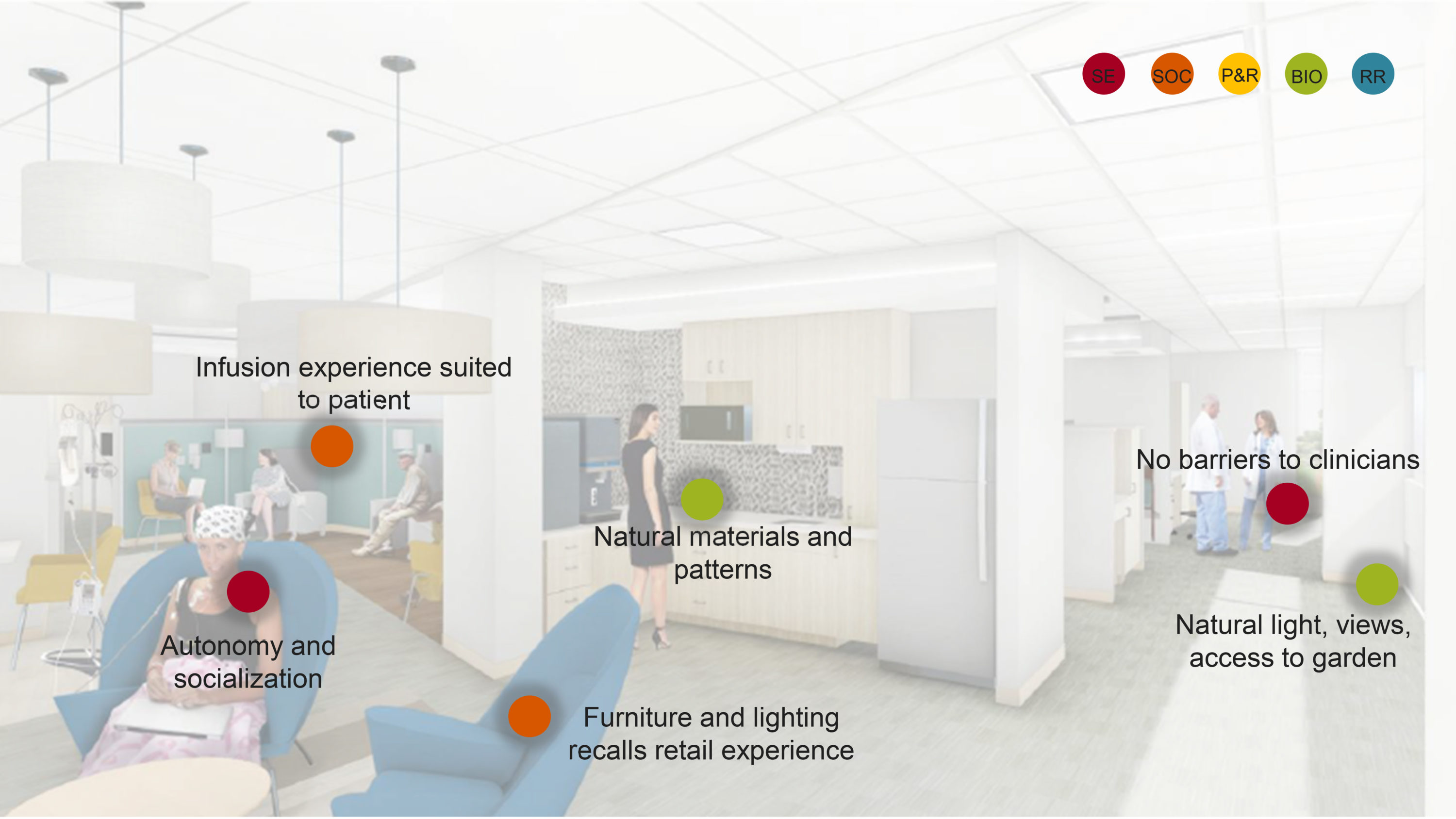
Infusion is a process, not a place. The infusion center offers the maximum amount of control and choice to patients, from private, semi-enclosed bays to more social open bays, to open lounge seating at tables and chairs for those who want to move around and seek out community (sense of coherence, self-efficacy). Natural light and views of the roof gardens create a restorative, biophilic connection to nature which is reinforced by the selection of natural materials and patterns for finishes within the infusion areas (biophilia, relaxation response). Decentralized staff work areas help make staff on this large unit extremely accessible (self-efficacy).
At the Thomas Comprehensive Care Center, salutogenic design helps transform the oncology experience to form something that might feel stressful and passive into an experience where patients feel active and in control. From the initial approach to the building’s clinical spaces—and all the spaces in between—the Thomas Center’s environment fosters patient empowerment, community, and wellness.
For an overview of GBBN’s approach to cancer care design, consult Culture of Cancer Care.
Angela Mazzi is an associate principal and medical planner in GBBN’s healthcare market. Harnessing studies on human psychology, research on our biological need for nature, and experience with LEAN strategies, Angela creates exceptional environments that help patients heal and empower professionals to deliver exemplary care.




